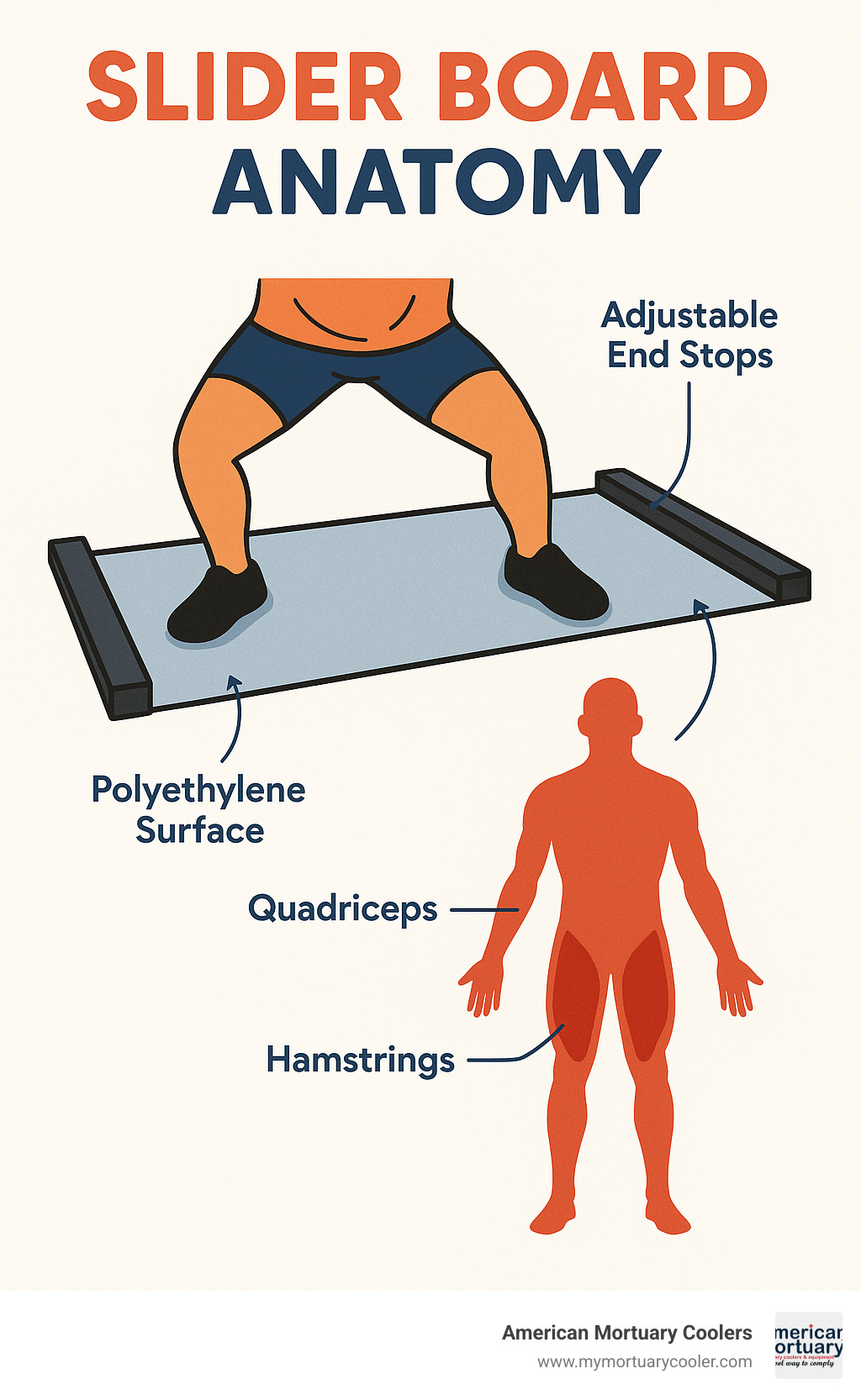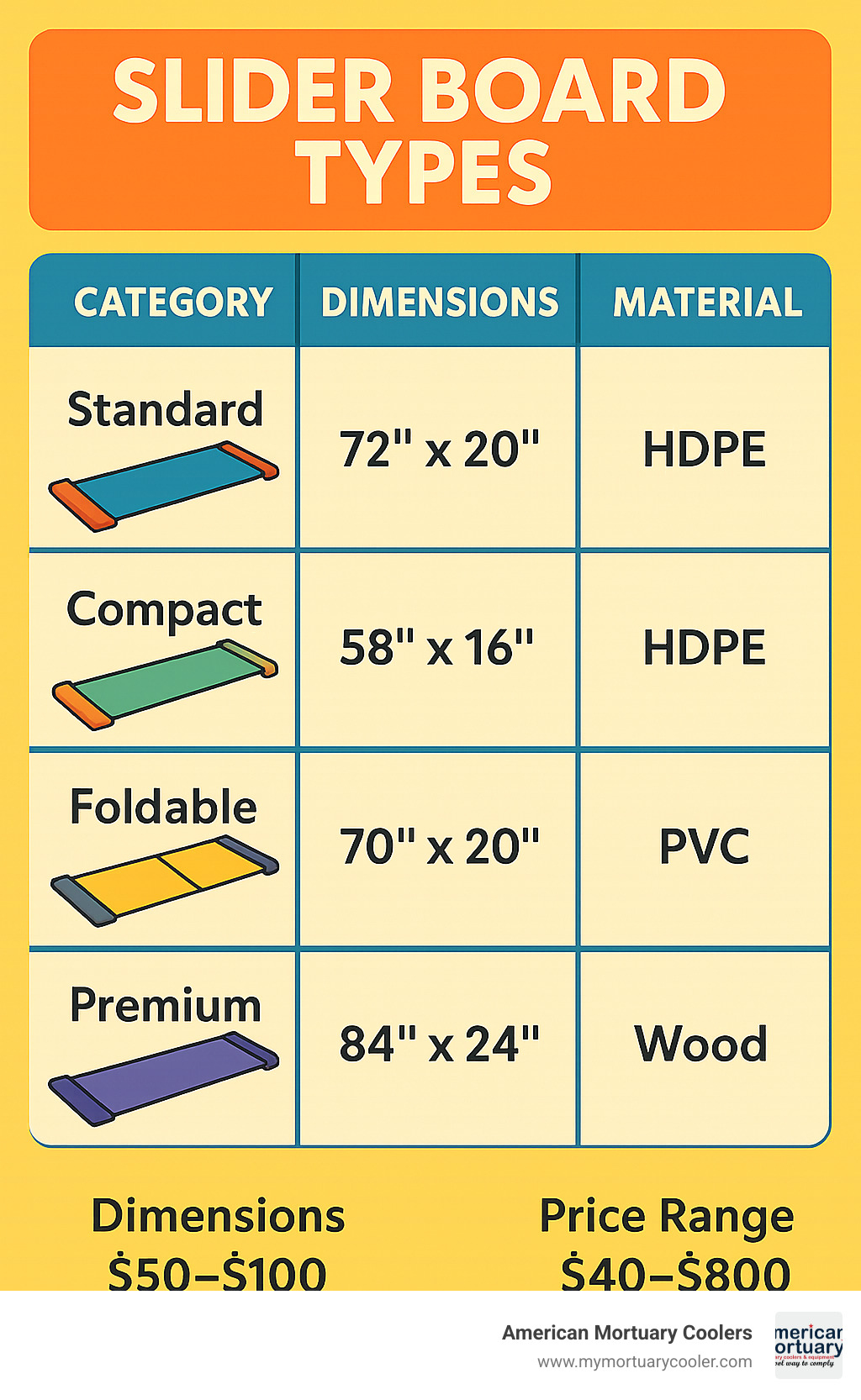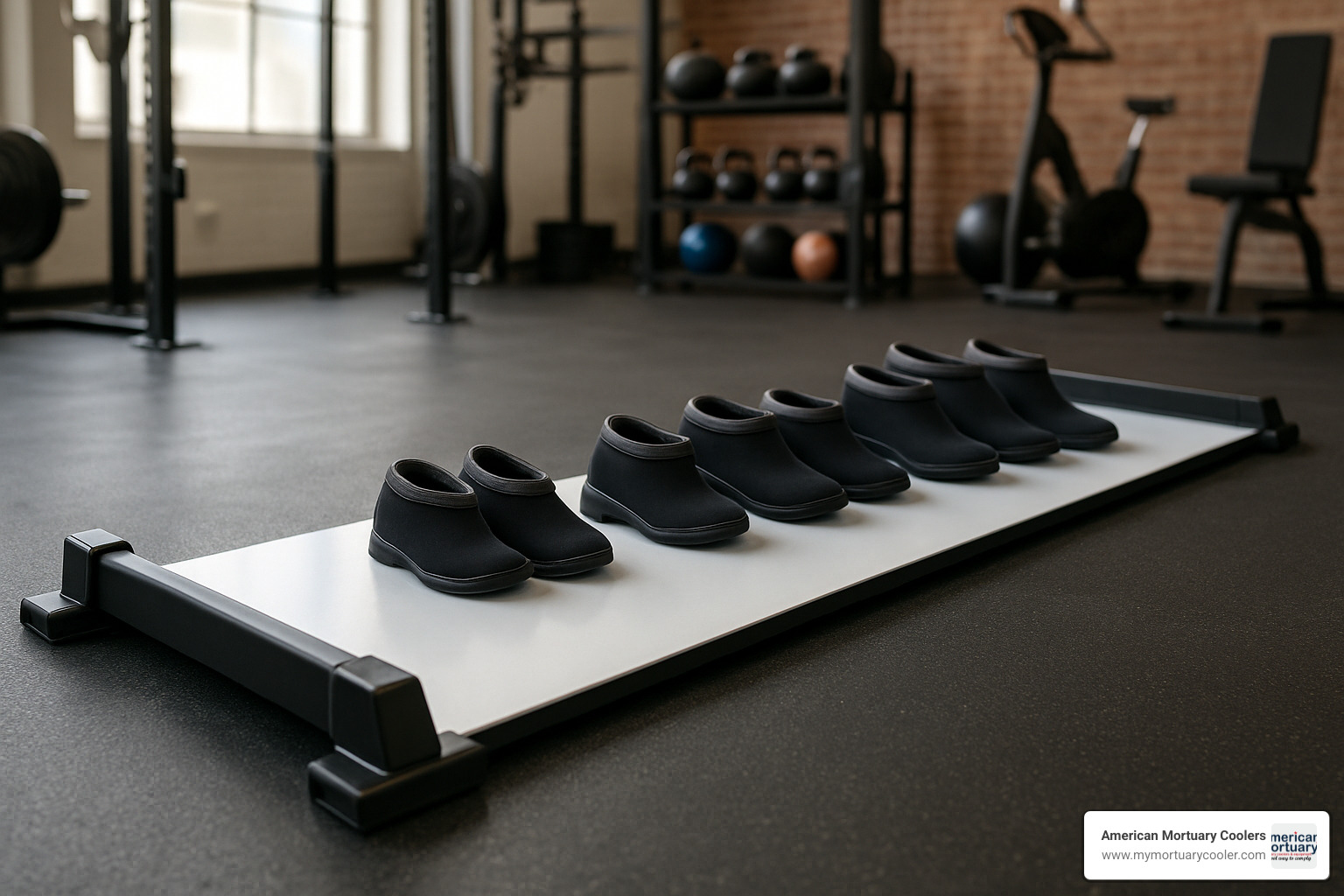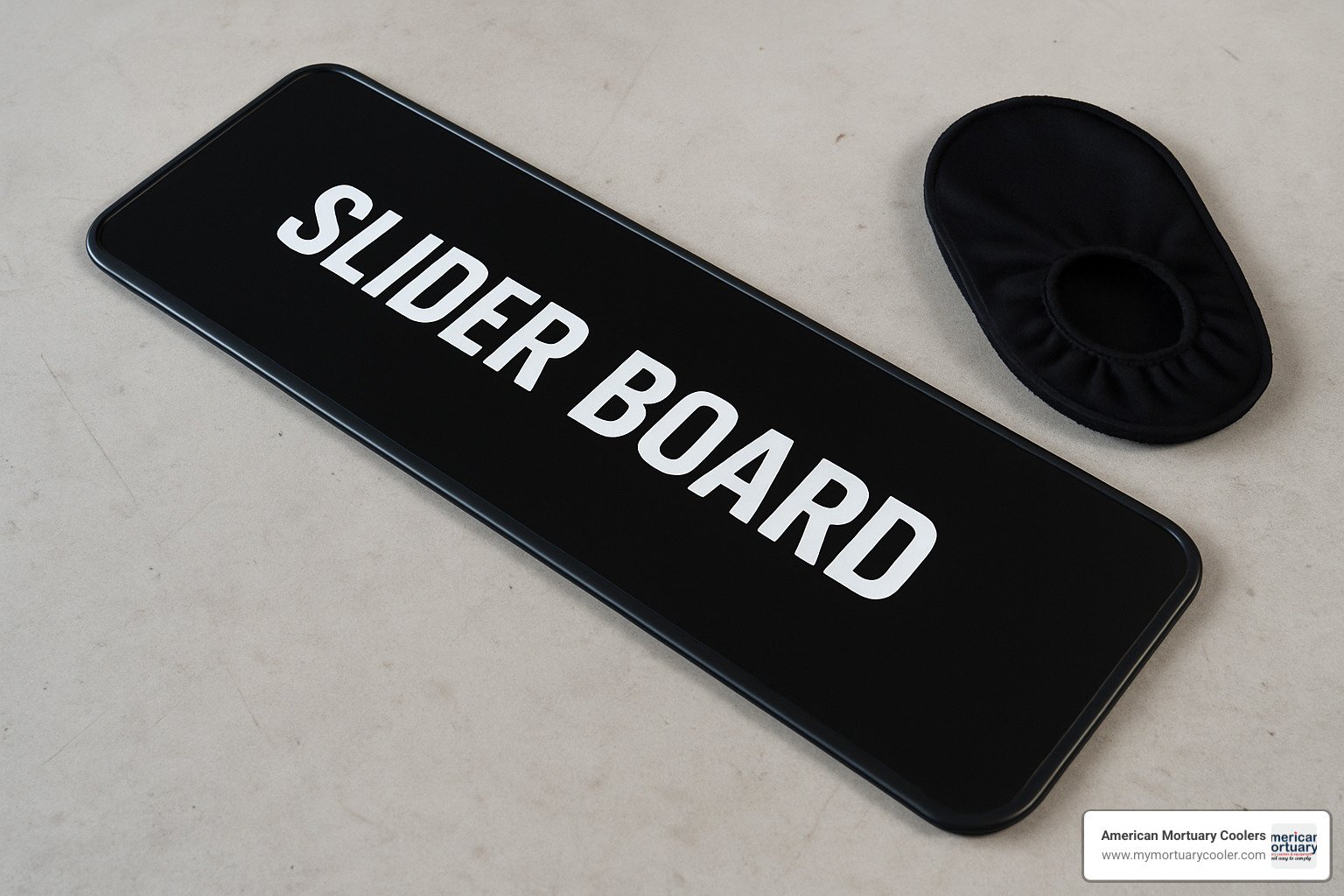Why Slider Boards Are the Ultimate Low-Impact Training Tool
A slider board is a smooth, low-friction surface that lets you glide laterally for cardio, strength, and rehab work.
Main Types:
- Fitness boards – 6-8 ft for lunges and core drills
- Hockey trainers – adjustable length with booties
- Medical transfer boards – safe patient movement
- Specialty boards – pizza peels, skimboards, mortuary sliders
Key Benefits:
- Burns more calories in less time than many traditional workouts
- Activates quads and hamstrings beyond regular lunges
- Joint-friendly, low impact
- Improves balance, coordination, and lateral agility
Price Range: $50-$500 (average $239.78)
Slider boards work by reducing friction between bootie-covered feet and a slick polyethylene or PVC surface; padded end stops let you push off and glide in a controlled path.
Studies show they boost muscle activation and improve hip- and knee-flexion angles. They’re now standard in professional and collegiate training rooms as well as physical-therapy clinics.
I’m Mortuary Cooler from American Mortuary Coolers. Our experience building commercial-grade sliding systems for funeral homes and medical facilities gives us a unique perspective on what makes these boards reliable for the long haul.

Terms related to slider board:
What Is a Slider Board and Why It Belongs in Your Training Toolkit
Think of a slider board as your personal ice rink - minus the ice and the risk of face-planting in front of strangers. It's a smooth, specialized surface that lets you glide side-to-side like a hockey player, but in the comfort of your own space.
The basic concept is brilliantly simple: you stand on a low-friction surface wearing special booties, then push off from padded end stops to glide laterally back and forth. What makes this so effective is the glide mechanics - your muscles have to work overtime to control the smooth sliding motion, giving you an incredible workout without the joint-pounding impact of traditional exercises.
Scientific research on hamstring activation shows that slider boards can significantly boost muscle activation in your quads and hamstrings compared to regular lunges or squats. Your body has to engage stabilizing muscles it normally ignores, creating a full-body challenge from what looks like simple side-to-side movement.
Rehabilitation use is where slider boards really prove their worth. Physical therapists love them because they provide controlled, progressive loading for patients recovering from knee surgeries, hip replacements, or ankle injuries. The smooth motion lets people rebuild strength and mobility without the jarring impact that could set back their recovery.
The stability training aspect challenges your proprioception - your body's internal GPS system. Every glide forces your core, legs, and even your arms to work together to keep you upright and controlled.
Most importantly, slider boards offer truly joint-friendly exercise. The smooth gliding eliminates the harsh impact of running or jumping, making it perfect for people with arthritis, previous injuries, or anyone who wants an effective workout without feeling like they got hit by a truck the next day.
Core Mechanism: How the Slider Surface and Booties Reduce Friction
The magic happens in the materials. Most quality boards use an HDPE sheet (high-density polyethylene) as the sliding surface. This incredibly smooth, durable material provides consistent glide characteristics through thousands of workouts.
Some boards opt for PVC film surfaces instead. These are typically thinner and more portable, making them great for travel or small spaces.
Slide polish is the unsung hero of smooth operation. This specialized silicone-based spray keeps the surface slick without making it dangerously slippery. Regular application ensures consistent performance and prevents the surface from becoming sticky or grabby over time.
The end stops complete the system. These adjustable, padded bumpers at each end provide the resistance you push against to start each glide. Quality boards let you adjust the distance between stops to match your stride length and fitness level.
Who Uses Slider Boards
Athletes use them for sport-specific training - hockey players simulate skating strides, basketball players work on lateral defensive moves, and soccer players improve their cutting ability. Nearly every major professional team has slider boards in their training facilities.
Physical therapists incorporate them into rehabilitation programs because they offer controlled movement in a safe environment. Seniors find slider boards particularly beneficial for maintaining mobility and balance. Fitness enthusiasts love the efficiency factor - you can get a killer full-body workout in a small space with minimal equipment.
Even medical staff in hospitals and funeral homes use specialized slider boards for safe patient and body transfers, proving that the sliding principle has applications far beyond fitness training.
Key Types of Slider Boards and How They Compare
When you're shopping for a slider board, you'll quickly find there's a whole world of options out there. From serious athletic training equipment to specialized medical devices, each type serves different needs and budgets.

Fitness & Sports Variants
The UltraSlide 8 has earned its reputation as the gold standard. This beast measures 96" x 23.5" and weighs a solid 36 pounds. What makes it special is the wood core construction that's been trusted by pros since 1993.
The four adjustable length settings (5, 6, 7, and 8 feet) mean it works for everyone from shorter athletes to tall basketball players. At $349.95, it's definitely an investment, but when you consider that nearly every MLB, NBA, NFL, and NHL team uses these boards, the price starts making sense.
The Brrrn Board+ takes a different approach. At 72" x 19.75" with a 400-pound weight capacity, it focuses on superior glide quality and premium materials. The $499 price tag reflects its high-end positioning.
Hockey players have their own specialized option with Better Hockey Extreme Slide Boards. These come with three different bootie sizes and adjustable lengths specifically designed to replicate skating strides.
The Obsidian Slide Boards have created quite a buzz with their bold claims about burning "twice the calories in half the time." Their system includes over 100 different workout routines, and users report some impressive results.
Medical & Rehabilitation Boards
Medical slider boards work on the same friction-reduction principle but serve completely different purposes. These boards help medical staff safely transfer patients between beds, stretchers, and examination tables without straining their backs or risking patient injury.
Standard medical boards come in three practical sizes: half-length (22" x 33") for shorter transfers, full-length (22" x 72") for standard patient movement, and bariatric width (32" x 72") for larger patients.
The MOBI Slider Board represents specialized mortuary applications, designed for transferring stretchers and gurneys with minimal effort. At 72.25" x 18.25" with a thin profile, it's perfect for facilities where storage space comes at a premium. More info about medical stretchers explains how these systems work together in medical settings.
Specialty & DIY Options
The sliding principle shows up in some pretty creative places. The SlideBoard pizza peel uses the same friction-reduction technology to help you slide pizzas into ovens effortlessly.
Skimboard sliders bridge water sports and land training, letting flatland skimboarders practice their technique when water isn't available.
For folks who need maximum portability, roll-up travel boards sacrifice some durability for convenience. They're popular with home users who have limited storage space or need to transport their board frequently.
The price range across all these types runs from about $50 for basic DIY options up to $500 for premium commercial models, with most quality boards averaging around $239.78.
Must-Have Features on a High-Quality Slider Board
Shopping for a slider board can feel overwhelming with so many options available, but focusing on the right features will help you find equipment that delivers years of reliable performance.

Length is your foundation decision. Most quality boards measure between 6 and 8 feet, which works perfectly for average-height users. But if you're over 6'2", seriously consider boards up to 10 feet long - having adequate stride length makes all the difference in your workout experience.
Adjustability transforms a good board into a great one. Quality models feature adjustable end stops that let you customize the sliding distance. This isn't just a nice-to-have feature - it's essential if multiple family members will use the board or if you want to progress your workouts over time.
The thickness factor typically ranges from 1/8" to 3/16". Thicker boards feel more stable and last longer, but they're also heavier to move around. It's a classic trade-off between durability and convenience that depends on your primary use case.
Portability needs vary dramatically depending on your situation. Rigid boards offer maximum stability during intense workouts but can be a pain to store in smaller homes. If you're tight on space, foldable designs provide an excellent middle ground without sacrificing too much performance.
Don't overlook weight capacity - this is where some people get burned by choosing budget options. Quality slider boards typically support 300-440 pounds, with commercial-grade models handling even more.
Accessory kits can make or break your experience. The best boards include multiple bootie sizes, slide polish, and carrying cases. These items are essential for proper function and buying them separately gets expensive fast.
Materials & Durability Checklist
High-density polyethylene (HDPE) is the gold standard for slider board surfaces. This material delivers consistent glide characteristics, resists cracking, and cleans easily - exactly what you want for long-term use.
Wood core construction adds serious structural integrity. Premium boards like the UltraSlide use wood cores covered with HDPE, combining natural strength with modern performance materials.
Polypropylene sheets offer a lighter alternative while maintaining good performance. You'll find these materials in more portable or budget-friendly options.
Urethane polish quality affects your board's performance for years to come. Quality manufacturers include or recommend specific polish formulations that maintain optimal glide without creating safety hazards.
Warranty coverage reveals a lot about manufacturer confidence. Commercial-grade boards often include multi-year warranties, while budget options may offer little protection.
Portability & Storage Hacks
Foldable models represent the most popular compromise between performance and convenience. These boards typically fold in half or thirds, dramatically reducing storage footprint while maintaining rigid construction during use.
Roll-up bags work brilliantly for boards with flexible surfaces. While these sacrifice some performance compared to rigid alternatives, they're unbeatable for users who travel frequently or have severe space constraints.
Wall rack hangers provide the cleanest storage solution if you have available wall space. These systems keep boards accessible, clean, and completely out of the way when not in use.
Buying Checklist: Step-by-Step Guide to Picking Your Perfect Slider Board
Finding the right slider board is easier when you break the process into a few clear steps.
The Definitive Guide to Buying the Perfect Sliding Board covers each point in depth, but here’s the quick version:
- Clarify your main use. Weekend workouts, rehab patients, or team training all demand different durability levels.
- Set a realistic budget. Quality models cluster around $239.78; commercial boards top out near $500, while starter versions run under $100.
- Match length to height and space. Users up to 5'10" are fine on 6 ft boards, while taller athletes may need 8 ft or more. Make sure you’ve got at least 2 ft of clearance at each end.
- Confirm shipping details. Rigid 30-40 lb boards may arrive by freight and add to total cost, so check before you order.
- Look at accessories and warranty. Booties, polish, and a carrying case save money later; multi-year coverage signals better build quality.
Comparing Popular Brands and Models
- UltraSlide – premium wood-core construction trusted by pro teams.
- SPRI – economical boards (~$50) that let newcomers test the waters.
- LifePro – roll-up models for tight spaces.
- Obsidian – equipment plus guided workouts.
Choose the package that delivers the best long-term value, not just the lowest sticker price.
Price vs Value Decision Matrix
Average cost reflects quality materials and engineering. A $300 board that lasts 20 years beats a $100 board that needs replacing every couple of seasons. Home users exercising twice a week can choose lighter models; clinics and gyms should invest in commercial grade for around-the-clock reliability.
Care, Cleaning, and Safety for Long-Lasting Performance
Taking care of your slider board isn't complicated, but it makes all the difference between equipment that lasts decades versus something that becomes a garage sale item after a few years.

The slide polish schedule is your board's lifeline. Commercial boards getting heavy daily use need weekly attention, while your home board might cruise along fine with monthly polishing. The sweet spot is maintaining that perfect glide without creating a slip-and-slide disaster.
Disinfectant wipes become especially important in shared spaces. In medical settings where we've installed specialized slider systems, hygiene isn't optional - it's critical. But not all cleaners play nice with your board's surface. Harsh chemicals can strip protective coatings or damage certain plastics.
Non-slip flooring around your board prevents those embarrassing (and potentially dangerous) moments when you step off the ultra-slick surface onto regular flooring. Smart users place rubber mats or textured strips right next to their boards.
Proper warm-up becomes even more crucial with slider boards because you're asking your body to move in ways it doesn't usually move. Those lateral motions and balance challenges require your muscles and joints to be ready for action.
Maintenance Routine
Weekly polish for commercial boards follows a simple but important process. Clean the surface first with appropriate cleaners, let it dry completely, then apply a thin, even coat of slide polish. A little goes a long way, and you can always buff out streaks or excess product.
Bootie laundering sounds simple until you ruin your first pair. Most booties handle machine washing just fine, but high heat is their enemy. Air drying takes longer but keeps your booties performing like new.
Surface inspection should become second nature. Look for cracks, gouges, or worn spots that could trip you up or affect performance. Small scratches often polish right out, but significant damage might need professional attention.
Storage tips are straightforward but often ignored. Keep your board somewhere dry and away from temperature extremes. Vertical storage using wall racks saves floor space and prevents warping.
Safety Best Practices When Using a Slider Board
Proper stance makes the difference between looking like a pro and looking like someone learning to ice skate. Keep your center of gravity low with knees slightly bent and your core engaged.
Bumper alignment needs checking before every session, especially on shared equipment. When end stops aren't positioned correctly or aren't tightened securely, you get unexpected stops or dangerous gaps that can catch your feet.
Weight limits aren't suggestions, they're engineering specifications. This is especially true for budget boards with lower capacity ratings. The forces during explosive movements can exceed your static weight significantly.
Partner spotting makes sense when you're learning new exercises or pushing intensity levels. Having someone there to provide stability or assistance reduces injury risk during those early sessions.
The safety principles we follow for specialized equipment installations apply here too. More info about power stair chair safety shows how proper attention to safety details makes all the difference in equipment performance and user confidence.
Frequently Asked Questions about Slider Boards
What length slider board should I buy for my height?
Choosing the right slider board length can make the difference between a great workout and a frustrating experience. Your height directly determines how much sliding distance you need for comfortable, effective movement.
If you're between 5'4" and 5'10", a 6-foot board will give you plenty of room for most exercises. You'll be able to achieve full lateral movement without feeling cramped or restricted. This length works particularly well for beginners who are still developing their sliding technique.
Taller users between 5'10" and 6'2" typically find 7-8 foot boards more comfortable. The extra length allows for fuller stride extension, which is crucial for getting the most out of your workout. You'll feel more natural in your movement patterns and be able to generate better power transfer.
For those over 6'2", consider investing in a 9-10 foot board if your budget and space allow. While these longer boards are less common and more expensive, they prevent that cramped feeling that can limit your workout quality.
Here's where adjustable boards really shine - they let you start shorter and gradually increase the sliding distance as your technique improves. This flexibility is invaluable if multiple family members will use the board or if you're not sure about your preferred length.
Can I safely use a slider board at home on hardwood floors?
Absolutely! Slider boards actually work beautifully on hardwood floors, but you'll want to take a few smart precautions to ensure safe use.
The biggest concern is keeping the board stationary during your workout. Quality boards include suction cups or rubber feet on the end stops specifically to prevent the entire board from sliding around on smooth surfaces. Without these features, you could find yourself in a dangerous situation where the board moves unexpectedly during use.
Safety around the board is just as important as the board itself. Consider placing rubber mats or textured strips around the perimeter to give you secure footing when getting on and off. The contrast between that ultra-slick board surface and your regular floor can catch you off guard if you're not prepared.
Make sure you have adequate clearance - at least 2-3 feet on all sides for safe movement. Take a few minutes to remove any obstacles, loose rugs, or furniture that could become hazards if you lose your balance. Your future self will thank you for this simple preparation.
The smooth surface of hardwood actually improves the board's performance, so once you've set up your safety zone, you'll likely find the experience even better than using it on carpet or other surfaces.
How do I keep my slider board slick without damaging the surface?
Maintaining that perfect glide is easier than you might think, but using the right approach makes all the difference for your slider board's longevity.
Start with the right products. Most manufacturers provide specific slide polish recommendations that are formulated for their surface materials. Silicone-based polishes generally work best and won't damage HDPE or similar materials. Whatever you do, avoid household furniture polishes or waxes - they can create buildup or react poorly with your board's surface.
Application technique matters just as much as product choice. Always clean the surface thoroughly before polishing, then apply a thin, even coat. If needed, buff the surface to eliminate streaks or excess product. Over-application can actually create dangerously slippery conditions, so less is definitely more here.
Timing depends on how often you use your board. Commercial facilities might need weekly attention, while home users typically find monthly polishing sufficient. The best gauge is how the board feels during use - if gliding becomes more difficult or inconsistent, it's time for some maintenance.
When in doubt about products or techniques, don't hesitate to contact your board's manufacturer. They know their materials best and can guide you toward products that will keep your board performing optimally for years to come.
Conclusion
Finding the perfect slider board doesn't have to be overwhelming when you know what to look for. The key is understanding your specific needs - whether that's sport-specific training, rehabilitation, or simply wanting an effective low-impact workout at home.
The research speaks for itself: slider boards deliver real results. They activate more muscle groups than traditional exercises, burn calories efficiently, and provide joint-friendly training that works for everyone from professional athletes to seniors recovering from surgery.
At American Mortuary Coolers, we've built our reputation on creating durable, custom equipment that performs reliably for decades. While our primary focus is mortuary equipment, the same engineering principles that make our cooling systems dependable apply to any sliding mechanism - quality materials matter, robust construction is non-negotiable, and user safety must come first.
Your investment in a quality slider board should center around a few critical factors: match the board length to your height (6 feet for most users under 5'10", 8 feet for taller individuals), prioritize HDPE construction for long-term durability, and don't skip the accessories - proper booties and slide polish are essential for safe, effective use.
The average price of $239.78 for a quality board represents excellent value when you consider the decades of use you'll get from proper equipment. Compare that to gym memberships or replacing cheaper boards every few years, and the math becomes clear.
Slider board training is uniquely effective because it challenges your body in ways traditional equipment can't. The lateral movement patterns, balance requirements, and controlled gliding motion work together to create workouts that are both challenging and safe for your joints.
For comprehensive details on evaluating specific models and features, The Definitive Guide to Buying the Perfect Sliding Board walks you through everything you need to make the best choice for your situation.
Whether you're a hockey player looking to improve your stride, someone working through physical therapy, or a fitness enthusiast wanting to try something new, the right slider board can transform your training routine. With proper care and maintenance, it's equipment that will serve you well for years to come.
















